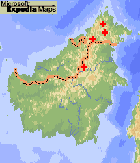 Range of Dacrydium gracilis (1). Adapted from a map by www.expediamaps.com | Dacrydium gracilis de Laubenfels 1988Common NamesTaxonomic notesDescription"Tree 7-30 m tall, up to 40 cm diam. Juvenile leaves at least 12 mm long, curved so that the tip is nearly parallel to the branch, pungent, triangular in cross section, lanceolate, up to 0.4 mm wide, at the base 0.2 mm thick. Adult leaves nearly straight, spreading at about a 45 angle but curved so the apex is parallel with the branch, apiculate, 3-9 mm long, the longer leaves on younger plants or lower on the tree, the shorter leaves on older and exposed trees, triangular in cross section, 0.4 mm wide, 0.2 mm thick. Fertile structures usually lateral. Pollen cones 6-7 mm long and 2 mm in diam., subtended by a cluster of leaves 3-5 mm long and usually distinctly shorter than normal foliage leaves. Together the two pollen sacs are 0.7-0.8 mm wide but the apex of the microsporophyll is a lanceolate spur 0.5-1 mm long and c. 0.3 mm wide. Seed-bearing structure also subtended by a cluster of reduced leaves c. 1 mm long, the bracts of the seed cone up to 3 mm long and more or less covering the epimatium, the usually solitary seed itself fully exposed. Fully mature seeds unknown..."Leaves smaller and much more gracile than those of the similar D. magnum which also occurs in lower elevation forest. The crown has a rather typical shape of a forest tree, not the striking form of the usually open growth species, D. beccarii" (1). RangeBorneo: Sabah (Mt. Kinabalu and S to the island's center) & Sarawak, at 950-1800 m. Grows scattered in the canopy of mountain rainforest; in Sarawak also in heath forest on sandstone; rare (1).Big TreeOldestDendrochronologyEthnobotanyObservationsRemarksCitations(1) de Laubenfels 1988. |
[Dacrydium] [Podocarpaceae] [home] This page is from the Gymnosperm Database |